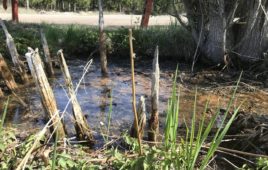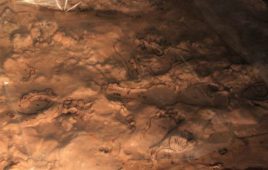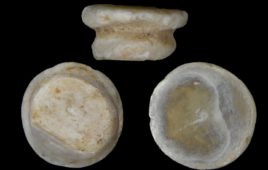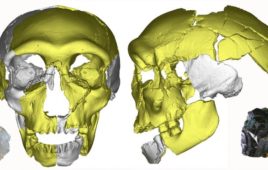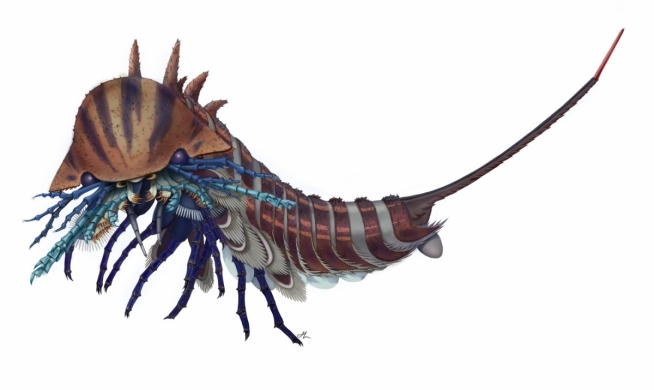
Artistic reconstruction of Habelia optata. Credit: Courtesy of Joanna Liang, © Royal Ontario Museum
A decades old mystery regarding a centuries old sea creature may have been solved.
Paleontologists from the Royal Ontario Museum and the University of Toronto have revealed more insight into the Habelia optata—a sea predator which belongs to the arthropods and lived during the middle Cambrian period about 508 million years ago—from fossil records found in the Burgess Shale fossil deposit in British Columbia.
The ancient sea creature, which is 2 cm in length with a tail as long as the rest of its body, has confounded scientists since it was discovered more than a century ago.
The fossil features a segmented body with external skeleton and jointed limbs, similar to all arthropods. However, scientists remained unsure for decades, which sub-group of arthropods Habelia belonged to.
Early studies had mentioned mandibulates — a hyper diverse lineage whose members possess antennae and a pair of specialized appendages known as mandibles, usually used to grasp, squeeze and crush their food.
However, the new research suggests that the sea creature was a close relative of the ancestor of all chelicerates—the other sub-group of arthropods currently living—due to the overall anatomy of the head in Habelia and the presence of two small chelicerae-like appendages found in the fossils.
“Habelia now shows in great detail the body architecture from which chelicerates emerged, which allows us to solve some long-standing questions,” lead author Cédric Aria, recent graduate of the Ph.D. program in the department of ecology & evolutionary biology in the Faculty of Arts & Science at U of T, said in a statement.
“We can now explain why, for instance, horseshoe crabs have a reduced pair of limbs – the chilaria – at the back of their heads,” he added. “Those are relics of fully-formed appendages, as chelicerates seem to originally have had heads with no less than seven pairs of limbs.”
The scientists analyzed 41 specimens, the majority of which are new specimens acquired by the ROM-led fieldwork in the Burgess Shale.
The research reveals the well-armored body of Habelia optatoa, covered in a multitude of different spines, was divided into head, thorax and post-thorax, all bearing different types of appendages.
The thorax displays five pairs of walking legs, while the post-thorax houses rounded appendages likely used in respiration.
“Scorpions and the now-extinct sea scorpions are also chelicerates with bodies divided into three distinct regions,” Aria said. “We think that these regions broadly correspond to those of Habelia.
“But a major difference is that scorpions and sea scorpions, like all chelicerates, literally ‘walk on their heads,’ while Habelia still had walking appendages in its thorax.”
Habelia’s head contains a series of five appendages made of a large plate with teeth for mastification, a leg-like branch with stiff bristle-like spines for grasping and an elongate, slender branch modified as a sensory or tactile appendage.
“This complex apparatus of appendages and jaws made Habelia an exceptionally fierce predator for its size,” Aria said. “It was likely both very mobile and efficient in tearing apart its prey.”
According to Aria, from an evolutionary point of view, Habelia is close to the point of divergence between chelicerates and mandibulates.
“But its similarities with mandibulates are secondary modifications of features that were in part already chelicerate in nature. This suggests that chelicerates originated from species with a high structural variability,” he said.
The study was published in BMC Evolutionary Biology.

